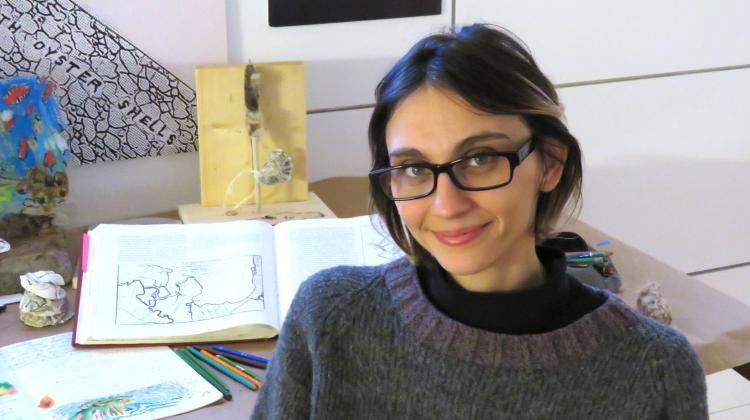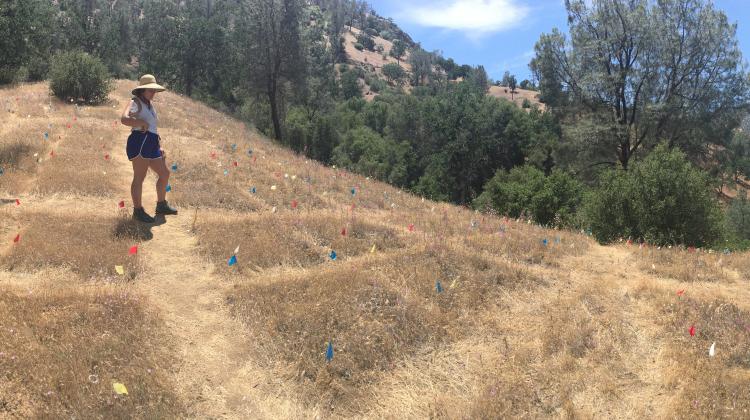With academic training in ecology and evolutionary biology, Aubrie James blends those passions with art in the ACT program.
By Olivia Mintz
Aubrie James' interest in science was ignited in her senior year of high school as she was learning chemistry. Though she did not specifically see herself studying chemistry in college, she saw STEM as an opportunity.
“I think something clicked for me,” says James “I realized that I could use tools to understand the world, ask questions, and then get answers. I thought, ‘I might do science.’”
Now enrolled in the program for Art, Culture, and Technology at MIT, James brings an extensive science background to her studies. An exhibition of her work spanning art and science entitled “shore/lime/line/light” is on view through January 14, 2024, at the Wiesner Student Art Gallery. The featured project traces “the pre-landmaking river shoreline through the MIT campus.”
James first attended Iowa State University, where she studied animal ecology and focused on researching birds and later, plants. After taking several field classes, she found a new appreciation for living things.
“I have an affinity with living things, but also the study of organisms in their environment,” says James. “When I think about these things, I feel more connected to the world.”
James attributes her PhD work in Ecology and Evolutionary Biology at Cornell as a gateway to finding connections between science and art. One experiment focused on how the interactions between plants and bees affect plant seed production. Because of the project’s 640 plots and many-colored flags, passersby thought the work was an art installation or a political statement.
Much of her work has been in ecology and in those experiments there were creative elements that generated insightful conversations about incorporating STEM and the arts.
“That planted a seed for me to question what I was doing,” says James. “What if it's not purely just an experiment?”
With her postdoc work completed, James wanted to find a way to combine the two disciplines. She explored several art programs including the ACT program, which she ultimately decided to be the best place for her because of the program’s capacity for “anarchic tinkering.” She cites the collaboration of varied entities on campus such as ACT and MIT.nano, a shared laboratory resource for the MIT community.
“I'm just really interested in reconfiguring my feeling of the world,” says James. “There are people in ACT who encourage that reconfiguration."
With her extensive training in the sciences, James thought that earning a Master of Science degree rather than a Master of Fine Arts degree made more sense for her career path.
“A Master of Science seemed coherent with what my intentions are, which is bringing art techniques, thinking, literature, and other art forms into a scientific practice.”
Through MIT, James has worked with many other ecologists and shared ideas about how far the limits of scientific ecology can go. She recently organized an academic panel during the Ecological Society of America (ESA) conference that centered on case studies of observations in the natural world that do not fit into preexisting theoretical frames.
James co-authored a paper about this session for the ESA Bulletin. The paper discusses mutualism, competition, and interdependence of plant communities and how these ideas can be further theorized in ecology.
“We're [James and other academic ecologists] reaching a moment where we're interested in historicizing and understanding different ways ecological models and theories that we use to understand nature frame our inquiry,” says James. “And then once you understand that, determining what happens next.”
After MIT, James is considering a career in academia. She taught biostatistics, ecology, and evolutionary biology classes while earning her doctorate and in her postdoctoral work, and is currently a teaching assistant for Creating Art, Thinking Science, which allows art students to work with MIT scientists who are skilled in science and engineering. As a professor, James wants to propose an interdisciplinary set of classes that integrate both fields.
“What matters to me is exploring and being close to organisms and the environment,” says James. “I hope to continue to do that in the way that I want, and I'm developing that foundation at ACT.”




